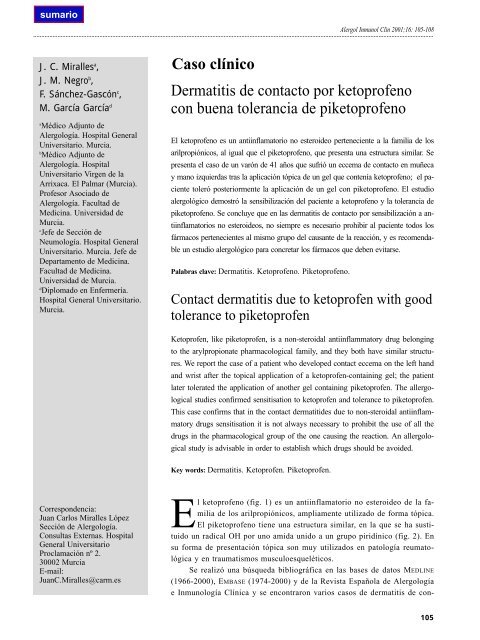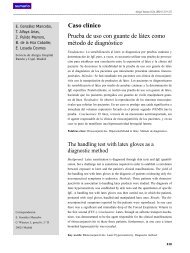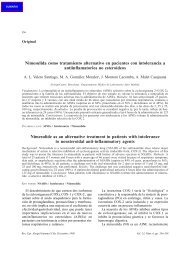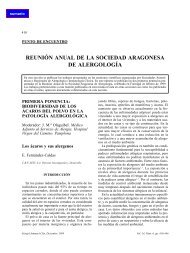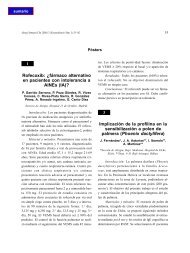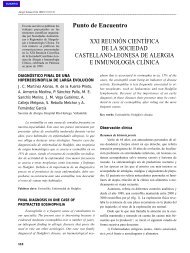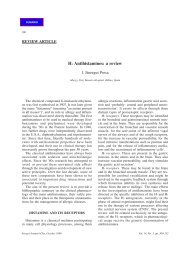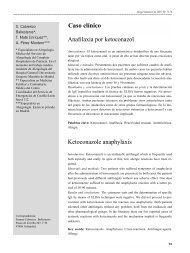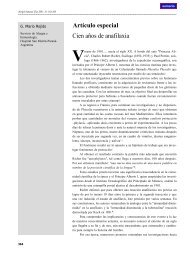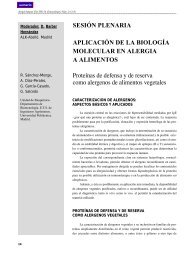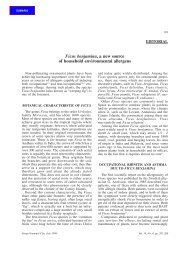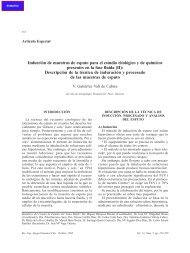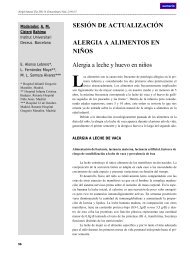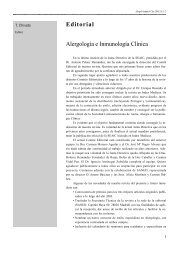Dermatitis de contacto - Alergología e Inmunología Clínica
Dermatitis de contacto - Alergología e Inmunología Clínica
Dermatitis de contacto - Alergología e Inmunología Clínica
You also want an ePaper? Increase the reach of your titles
YUMPU automatically turns print PDFs into web optimized ePapers that Google loves.
J. C. Miralles a ,<br />
J. M. Negro b ,<br />
F. Sánchez-Gascón c ,<br />
M. García García d<br />
a Médico Adjunto <strong>de</strong><br />
<strong>Alergología</strong>. Hospital General<br />
Universitario. Murcia.<br />
b Médico Adjunto <strong>de</strong><br />
<strong>Alergología</strong>. Hospital<br />
Universitario Virgen <strong>de</strong> la<br />
Arrixaca. El Palmar (Murcia).<br />
Profesor Asociado <strong>de</strong><br />
<strong>Alergología</strong>. Facultad <strong>de</strong><br />
Medicina. Universidad <strong>de</strong><br />
Murcia.<br />
c Jefe <strong>de</strong> Sección <strong>de</strong><br />
Neumología. Hospital General<br />
Universitario. Murcia. Jefe <strong>de</strong><br />
Departamento <strong>de</strong> Medicina.<br />
Facultad <strong>de</strong> Medicina.<br />
Universidad <strong>de</strong> Murcia.<br />
d Diplomado en Enfermería.<br />
Hospital General Universitario.<br />
Murcia.<br />
Correspon<strong>de</strong>ncia:<br />
Juan Carlos Miralles López<br />
Sección <strong>de</strong> <strong>Alergología</strong>.<br />
Consultas Externas. Hospital<br />
General Universitario<br />
Proclamación nº 2.<br />
30002 Murcia<br />
E-mail:<br />
JuanC.Miralles@carm.es<br />
Caso clínico<br />
Alergol Inmunol Clin 2001;16: 105-108<br />
<strong>Dermatitis</strong> <strong>de</strong> <strong>contacto</strong> por ketoprofeno<br />
con buena tolerancia <strong>de</strong> piketoprofeno<br />
El ketoprofeno es un antiinflamatorio no esteroi<strong>de</strong>o perteneciente a la familia <strong>de</strong> los<br />
arilpropiónicos, al igual que el piketoprofeno, que presenta una estructura similar. Se<br />
presenta el caso <strong>de</strong> un varón <strong>de</strong> 41 años que sufrió un eccema <strong>de</strong> <strong>contacto</strong> en muñeca<br />
y mano izquierdas tras la aplicación tópica <strong>de</strong> un gel que contenía ketoprofeno; el paciente<br />
toleró posteriormente la aplicación <strong>de</strong> un gel con piketoprofeno. El estudio<br />
alergológico <strong>de</strong>mostró la sensibilización <strong>de</strong>l paciente a ketoprofeno y la tolerancia <strong>de</strong><br />
piketoprofeno. Se concluye que en las <strong>de</strong>rmatitis <strong>de</strong> <strong>contacto</strong> por sensibilización a antiinflamatorios<br />
no esteroi<strong>de</strong>os, no siempre es necesario prohibir al paciente todos los<br />
fármacos pertenecientes al mismo grupo <strong>de</strong>l causante <strong>de</strong> la reacción, y es recomendable<br />
un estudio alergológico para concretar los fármacos que <strong>de</strong>ben evitarse.<br />
Palabras clave: <strong>Dermatitis</strong>. Ketoprofeno. Piketoprofeno.<br />
Contact <strong>de</strong>rmatitis due to ketoprofen with good<br />
tolerance to piketoprofen<br />
Ketoprofen, like piketoprofen, is a non-steroidal antiinflammatory drug belonging<br />
to the arylpropionate pharmacological family, and they both have similar structures.<br />
We report the case of a patient who <strong>de</strong>veloped contact eccema on the left hand<br />
and wrist after the topical application of a ketoprofen-containing gel; the patient<br />
later tolerated the application of another gel containing piketoprofen. The allergological<br />
studies confirmed sensitisation to ketoprofen and tolerance to piketoprofen.<br />
This case confirms that in the contact <strong>de</strong>rmatiti<strong>de</strong>s due to non-steroidal antiinflammatory<br />
drugs sensitisation it is not always necessary to prohibit the use of all the<br />
drugs in the pharmacological group of the one causing the reaction. An allergological<br />
study is advisable in or<strong>de</strong>r to establish which drugs should be avoi<strong>de</strong>d.<br />
Key words: <strong>Dermatitis</strong>. Ketoprofen. Piketoprofen.<br />
El ketoprofeno (fig. 1) es un antiinflamatorio no esteroi<strong>de</strong>o <strong>de</strong> la familia<br />
<strong>de</strong> los arilpropiónicos, ampliamente utilizado <strong>de</strong> forma tópica.<br />
El piketoprofeno tiene una estructura similar, en la que se ha sustituido<br />
un radical OH por uno amida unido a un grupo piridínico (fig. 2). En<br />
su forma <strong>de</strong> presentación tópica son muy utilizados en patología reumatológica<br />
y en traumatismos musculoesqueléticos.<br />
Se realizó una búsqueda bibliográfica en las bases <strong>de</strong> datos MEDLINE<br />
(1966-2000), EMBASE (1974-2000) y <strong>de</strong> la Revista Española <strong>de</strong> <strong>Alergología</strong><br />
e <strong>Inmunología</strong> <strong>Clínica</strong> y se encontraron varios casos <strong>de</strong> <strong>de</strong>rmatitis <strong>de</strong> con-<br />
105
J.C. Miralles, et al.<br />
tacto 1-6 y foto<strong>de</strong>rmatitis 7-12 por ketoprofeno, así como un<br />
caso <strong>de</strong> <strong>de</strong>rmatitis <strong>de</strong> <strong>contacto</strong> por piketoprofeno 13 y<br />
otro <strong>de</strong> foto<strong>de</strong>rmatitis <strong>de</strong> <strong>contacto</strong> por ketoprofeno y<br />
piketoprofeno 14 . También se han publicado varios casos<br />
<strong>de</strong> sensibilización cruzada entre ketoprofeno y otros<br />
antiinflamatorios no esteroi<strong>de</strong>os <strong>de</strong>l grupo <strong>de</strong> arilpropiónicos,<br />
como ibuproxam 15 , flurbiprofen y ácido tiaprofénico<br />
8,11 .<br />
Se presenta el caso <strong>de</strong> un paciente que acudió a la<br />
consulta por haber sufrido una reacción local importante<br />
tras aplicación <strong>de</strong> un gel con ketoprofeno.<br />
OBSERVACIÓN CLÍNICA<br />
Varón <strong>de</strong> 41 años, que refería que hacía unos 4<br />
años, tras aplicarse <strong>de</strong> forma tópica Fastum Gel® (ketoprofeno,<br />
alcohol etílico, carbómero, dietanolamina,<br />
esencia <strong>de</strong> lavanda, parahidroxibenzoato <strong>de</strong> metilo, parahidroxibenzoato<br />
<strong>de</strong> propilo) en la muñeca izquierda,<br />
inició, a las 8 horas y sin relación con exposición solar,<br />
un eritema cutáneo en la zona <strong>de</strong> aplicación, que<br />
<strong>de</strong>spués se extendió por toda la mano con aparición <strong>de</strong><br />
ampollas y posterior <strong>de</strong>scamación; persistió un total <strong>de</strong><br />
15 días y precisó tratamiento con antihistamínicos orales<br />
y corticoi<strong>de</strong>s tópicos.<br />
Posteriormente, el paciente se aplicó, en diversas<br />
zonas cutáneas, Calmatel Gel“ (piketoprofeno, hidróxido<br />
propilcelulosa, propilenglicol, esencia <strong>de</strong> lavanda,<br />
alcohol etílico), con una buena tolerancia.<br />
Estudio alergológico<br />
Se realizaron pruebas cutáneas por el método<br />
prick test con una batería <strong>de</strong> neumoalergenos prevalentes<br />
en nuestro medio (hongos <strong>de</strong> ambiente, ácaros <strong>de</strong>l<br />
polvo doméstico, caspa y epitelios <strong>de</strong> animales y pólenes)<br />
con resultado negativo.<br />
Se llevaron a cabo pruebas epicutáneas con una<br />
batería estándar <strong>de</strong> alergenos <strong>de</strong> <strong>contacto</strong> (True Test®–<br />
ALK Abello) que resultaron negativas.<br />
Posteriormente se relizaron pruebas epicutáneas<br />
con los diferentes componentes <strong>de</strong>l Fastum Gel® (ketoprofeno,<br />
alcohol etílico, carbómero, dietanolamina,<br />
esencia <strong>de</strong> lavanda, parahidroxibenzoato <strong>de</strong> metilo y<br />
parahidroxibenzoato <strong>de</strong> propilo), así como con piketoprofeno.<br />
La prueba resultó positiva, a las 48 y 96 horas,<br />
para ketoprofeno al 2% en vaselina, con aparición<br />
<strong>de</strong> eritema, infiltración y algunas microvesículas (+++)<br />
106<br />
Fig. 1. Ketoprofeno.<br />
(fig. 3), y fue negativa para piketoprofeno y para el<br />
resto <strong>de</strong> componentes testados.<br />
Para valorar la tolerancia oral <strong>de</strong> otros propiónicos,<br />
se realizó posteriormente una prueba <strong>de</strong> provocación<br />
oral con dosis crecientes <strong>de</strong> ibuprofeno, hasta una<br />
dosis <strong>de</strong> 600 mg, con resultado negativo.<br />
El paciente toleraba perfectamente, por vía oral,<br />
tanto el paracetamol como el ácido acetilsalicílico, por<br />
lo que no se realizaron pruebas <strong>de</strong> provocación con<br />
otros antiinflamatorios no esteroi<strong>de</strong>os.<br />
DISCUSIÓN<br />
o<br />
CH 3<br />
El ketoprofeno es un antiinflamatorio no esteroi<strong>de</strong>o,<br />
perteneciente al grupo <strong>de</strong> los arilpropiónicos, ampliamente<br />
utilizado <strong>de</strong> forma tópica, que posee una<br />
<strong>de</strong>stacada capacidad <strong>de</strong> sensibilización. Se han <strong>de</strong>scrito<br />
en la literatura bastantes casos <strong>de</strong> <strong>de</strong>rmatitis <strong>de</strong> <strong>contacto</strong><br />
1-6 y foto<strong>de</strong>rmatitis 7-12 por ketoprofeno. A<strong>de</strong>más, se ha<br />
podido comprobar la existencia <strong>de</strong> reactividad cruzada,<br />
en algunos pacientes, entre ketoprofeno y otros antiinflamatorios<br />
no esteroi<strong>de</strong>os pertenecientes al mismo<br />
grupo, como ibuproxam, flurbiprofen y ácido tiaprofénico<br />
8 , así como entre ketoprofeno y moléculas que contienen<br />
benzofenonas como el fenofibrato 11,16 y entre ketoprofeno<br />
y mezclas <strong>de</strong> fragancias, especialmente<br />
al<strong>de</strong>hido cinámico y bálsamo <strong>de</strong>l Perú 17 .<br />
El paciente estudiado mostró una <strong>de</strong>rmatitis <strong>de</strong><br />
<strong>contacto</strong> por sensibilización a ketoprofeno y toleró, sin<br />
embargo, otro antiinflamatorio similar, piketoprofeno,<br />
pertenecientes ambos al grupo <strong>de</strong> los arilpropiónicos;<br />
o<br />
OH<br />
Ácido 3-benzoil-alfa-metilbencenoacético (C16H14O3)<br />
PM = 254,29
Fig. 2. Piketoprofeno.<br />
o<br />
CH 3<br />
en algún otro caso se ha objetivado reactividad cruzada<br />
entre ambos fármacos 14 .<br />
Los dos comparten una estructura similar, en la<br />
que el radical COOH terminal <strong>de</strong>l ketoprofeno (fig. 1)<br />
se ha sustituido por uno amida unido a un anillo piridínico<br />
en el piketoprofeno (fig. 2). Cabría especular que<br />
esta sustitución modifique la estructura antigénica <strong>de</strong>l<br />
fármaco, o que, dado que son productos <strong>de</strong> bajo peso<br />
molecular que se comportan como haptenos, que la pérdida<br />
<strong>de</strong>l COOH terminal modifique su capacidad para<br />
unirse a las proteínas dérmicas, con lo que el piketoprofeno<br />
resulte menos sensibilizante que el ketoprofeno.<br />
Como ilustra este caso, a pesar <strong>de</strong> la capacidad <strong>de</strong><br />
sensibilización cruzada <strong>de</strong>l ketoprofeno con otros antiinflamatorios<br />
no esteroi<strong>de</strong>os <strong>de</strong> su grupo farmacológico,<br />
en presencia <strong>de</strong> una <strong>de</strong>rmatitis <strong>de</strong> <strong>contacto</strong> por sensibilización<br />
a uno <strong>de</strong> estos fármacos, no siempre es<br />
necesario prohibir al paciente todos los pertenecientes<br />
al mismo grupo <strong>de</strong>l causante <strong>de</strong> la reacción, y es conveniente<br />
la realización <strong>de</strong> pruebas epicutáneas con varios<br />
<strong>de</strong> estos fármacos y comprobar el grado <strong>de</strong> sensibilización<br />
<strong>de</strong>l paciente.<br />
AGRADECIMIENTOS<br />
Quisiéramos expresar nuestro agra<strong>de</strong>cimiento al<br />
Dr. Don José María Alonso Herreros, Jefe <strong>de</strong> la Unidad<br />
Técnica <strong>de</strong> Farmacia Hospitalaria <strong>de</strong>l Hospital General<br />
Universitario y a María Ascensión Aparicio Carrión,<br />
farmacéutica alumna <strong>de</strong>l Hospital General Universitario<br />
<strong>de</strong> Murcia, por su inestimable ayuda.<br />
o<br />
H<br />
CH 3<br />
3-Benzoil-alfa-metil N-(4-metil-2piridinil) bencenoacetamida (C22H20N2=2)<br />
PM = 344,41<br />
N<br />
<strong>Dermatitis</strong> <strong>de</strong> <strong>contacto</strong> por ketoprofeno con buena tolerancia <strong>de</strong> piketoprofeno<br />
Fig. 3.<br />
REFERENCIAS BIBLIOGRÁFICAS<br />
1. Valsecchi R, Falgheri G, Cainelli T. Contact <strong>de</strong>rmatitis from ketoprofen.<br />
Contact <strong>Dermatitis</strong> 1983; 9: 163-164.<br />
2. Angelini G, Vena GA. Contact allergy to ketoprofen. Contact <strong>Dermatitis</strong><br />
1983; 9: 234.<br />
3. Camarasa JG. Contact <strong>de</strong>rmatitis to ketoprofen. Contact <strong>Dermatitis</strong><br />
1985; 12: 120-122.<br />
4. Mozzanica N, Pucci M, Pigatto P. Contact allergy from ketoprofen.<br />
Contact <strong>Dermatitis</strong> 1987; 17: 325-326.<br />
5. Lanzarini M, Bar<strong>de</strong>zzi F, Morelli R, Reggiani M. Contact allergy to<br />
ketoprofen. Contact <strong>Dermatitis</strong> 1989; 21: 51.<br />
6. Tosti A, Gaddoni G, Valeri F, Bardazzi F. Contact allergy to ketoprofen:<br />
report of 7 cases. Contact <strong>Dermatitis</strong> 1990; 23: 112-113.<br />
7. Cusano F, Rafenelli A, Bacchilega R, Errico G. Photo-contact <strong>de</strong>rmatitis<br />
from ketoprofen. Contact <strong>Dermatitis</strong> 1987; 17: 108-109.<br />
8. Mozzanica M, Pigatto PD. Contact and photocontact allergy to ketoprofen:<br />
clinical and experimental study. Contact <strong>Dermatitis</strong> 1990;<br />
23: 336-340.<br />
9. Cusano F, Capozzi M. Photocontact <strong>de</strong>rmatitis from ketoprofen with<br />
cross-reactivity to ibuproxam. Contact <strong>Dermatitis</strong> 1992; 27: 50-51.<br />
107
J.C. Miralles, et al.<br />
10. Nabeya RT. Kojima T, Fujita M. Photocontact <strong>de</strong>rmatitis from ketoprofen<br />
with an unusual clinical feature. Contact <strong>Dermatitis</strong> 1995;<br />
32: 52-3.<br />
11. Le Coz CJ, Bottlaen<strong>de</strong>r A, Scrivener JN, Santinelli F, Cribier BJ,<br />
Heid E, et al. Photocontact <strong>de</strong>rmatitis from ketoprofen and tiaprofenic<br />
acid: cross-reactivity study in 12 consecutive patients. Contact<br />
<strong>Dermatitis</strong> 1998; 38: 245-252.<br />
12. Horn HM, Humphreys F, Aldridge RD. Contact <strong>de</strong>rmatitis and<br />
prolonged photosensitivity induced by ketoprofen and associated with<br />
sensitivity to benzophenone-3. Contact <strong>Dermatitis</strong> 1998; 38: 353-<br />
354.<br />
13. Navarro LA, Jorro G, Morales C, Peláez A. Allergic contact <strong>de</strong>rmatitis<br />
due to piketoprofen. Contact <strong>Dermatitis</strong> 1995; 32: 181.<br />
108<br />
14. Gracia Bara MT, Matheu V, Pérez Montero A, Díaz Jara MP, Martínez<br />
Molero MI, Zapatero L. Foto<strong>de</strong>rmatitis <strong>de</strong> <strong>contacto</strong> por ketoprofeno<br />
y piketoprofeno. Allergol Inmunol Clin 1999; 14: 148-150.<br />
15. Valsecchi R, Cainelli T. Contact <strong>de</strong>rmatitis from ibuproxam. A case<br />
with cross-reactivity with ketoprofen. Contact <strong>Dermatitis</strong> 1990; 22: 51.<br />
16. Serrano G, Fortea JM, Latasa JM, Millán F, Janes C, Bosca F, et<br />
al. Photosensitivity induced by fibric acid <strong>de</strong>rivatives and its relation<br />
to photocontact <strong>de</strong>rmatitis to ketoprofen. J Am Acad Dermatol 1992;<br />
27 (2 Pt 1): 204-208.<br />
17. Pigatto P, Bigardi A, Legori A, Valsecchi R, Picardo M. Cross-reactions<br />
in patch testing and photopatch testing with ketoprofen, thiaprophenic<br />
acid, and cinnamic al<strong>de</strong>hy<strong>de</strong>. Am J Contact Dermat<br />
1996; 7: 220-223.


